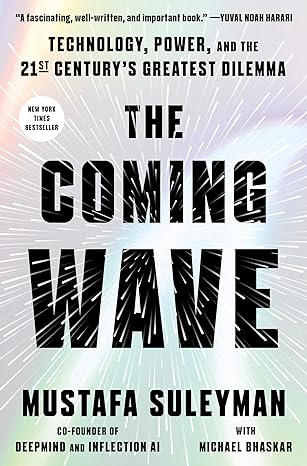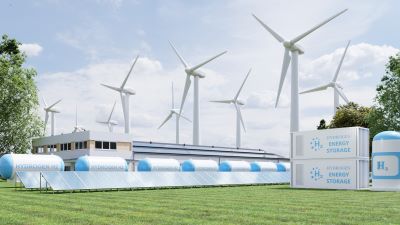The 21st century’s greatest dilemma: Containing AI and synthetic biology
.jpg) Peter Josty is Executive Director of the Centre for Innovation Studies in Calgary.
Peter Josty is Executive Director of the Centre for Innovation Studies in Calgary.
It is rare to find a book endorsed by the CEOs of Microsoft and Google, the UK foreign secretary, a Nobel Prize winner in economics, a UN undersecretary general, Bill Gates, Israeli author and historian Yuval Noah Harari, and many others. This book is on the New York Times and Sunday Times best seller list as well as an Economist book of the year.
 The Book is The Coming Wave – Technology, Power and the 21st Century’s Greatest Dilemma by Mustafa Suleyman (published by Crown Publishing, New York).
The Book is The Coming Wave – Technology, Power and the 21st Century’s Greatest Dilemma by Mustafa Suleyman (published by Crown Publishing, New York).
Suleyman has been a leader in developing artificial intelligence for many years. He is the co-founder of Deep Blue, former vice-president for AI at Google, CEO of Inflection, and one of the most knowledgeable people on the planet about AI. Some of his reviewers call him the ultimate insider.
Suleyman starts by describing the impact of previous General Purpose Technologies (GPTs) on society. GPTs are technologies that have so many applications that they affect every aspect of society and drive strong economic growth as they create new opportunities and new ways of doing business.
Examples include electricity, steam power and the internet. These technologies profoundly changed many aspects of society as they diffused around the world. Suleyman gives examples of how they changed wealth creation, power, politics, warfare and even human relations.
When a GPT first appears people have no idea what it will evolve into in the future. For example, British mathematician and computer scientist Alan Turing, widely considered to be the father of theoretical computer science, could never have predicted social media, Wikipedia or cyberattacks.
This book focuses on the impact of two new General Purpose Technologies – artificial intelligence and synthetic biology, and their expected effects – positive and negative.
The inevitability of GPTs and the need for containment
There is a certain inevitability about the growth of a GPT, and they have unpredictable and far-reaching consequences. This is because of the numerous opportunities they create and the incentives that exist for people to make money from them.
Suleyman gives the example of the internal combustion engine and its use in automobiles. The first cars were expensive and beyond the reach of all but the very rich. There were no paved roads and no gas stations. As technology improved cars became cheaper, and eventually millions were sold. Along with the development of the car went the development of all the ancillary structures needed, including roads, gas stations, training in auto mechanics, car dealerships and related infrastructure.
As the use of cars expanded, problems were noticed – some drivers were dangerous, people were injured and killed, cars were polluting and noisy, and they often broke down. Eventually a host of new structures came into being to offset the negative effects of the car – speed limits, car warranties, driving tests, training for auto mechanics, streetlights, stop signs, developing safer roads, and many more.
Suleyman calls these offsetting factors “containment,” and much of the book discusses the types of containment that might be used to offset the dangers arising from AI and synthetic biology. He sees this as the greatest dilemma of the 21st century. He notes that containment is a complex process and many different steps will be needed.
What’s so world-changing about AI and synthetic biology?
Suleyman describes how neural networks learn when they are trained on large amounts of data. (Geoffrey Hinton at the University of Toronto built the original neural network). Suleyman describes how AI today can do things that were impossible 10 years ago – discovering new drugs, model fusion reactors, manage traffic flows, develop self-driving cars, and numerous others.
Large language models like ChatGPT act like a supersized chat box. But the technology is advancing rapidly with numerous AI researchers around the world. As Suleyman puts it, “AI is far deeper and more powerful than just another technology . . . We are really at a turning point in the history of humanity.”
Key to understanding the impact of synthetic biology is the recognition that DNA is information. The cost of sequencing human DNA fell from $1 billion in 2003 to well under $1,000 in 2022. It is now possible to buy a DNA printer that can build completely new molecules.
This has given rise to the new field of synthetic biology – the ability to read, edit and write the code of life. Research is underway on topics such as viruses that produce batteries, proteins that purify dirty water, organs grown in vats, and many more.
Medicine is another big focus. San Diego-based biotechnology company Altos Labs raised more than $3 billion in startup funding to study anti-aging. LanzaTech, a carbon recycling company based in Illinois, uses genetically engineered bacteria to convert waste CO2 from steel mills into widely used industrial chemicals.
There is a strong connection between AI and synthetic biology. For instance, DeepMind’s AlphaFold program can solve the protein folding problem that has puzzled scientists for 50 years.
Characteristics and threats of AI and synthetic biology
Suleyman sees AI and synthetic biology as having four key characteristics:
- Asymmetry – Companies and organizations that possess these new GPTs will outperform those who don’t have them and their traditional technologies.
- Hyper-evolution – Evolution will be fast and exponential.
- Omni-use – Like all GPTs, AI and synthetic biology will be used everywhere.
- Autonomy and beyond – Constant oversight of machines may no longer be necessary.
Suleyman sees both AI and synthetic biology as threatening the durability and even the existence of the nation state, especially the liberal democratic nation state. Both technologies can undermine the trust that is the basis for and foundation of the nation state. AI can disseminate false information effectively – cybercrime is already a big and growing problem. A single person with a DNA printer could make a virulent disease that could cause a pandemic.
There are serious threats from these GPT technologies that our current institutions are not designed to handle, and Suleyman believes they have the potential for catastrophe.
Can AI and synthetic biology be contained?
Suleyman is not at all convinced that the new technologies can be contained and their negative aspects held in check. He proposes steps that, taken together, could work:
- Safety – concrete technical measures to alleviate harm and maintain control.
- Audits – a means to ensure transparency and accountability.
- Choke points – levers to slow development and buy time for regulators and defensive technologies.
- Makers – ensuring responsible developers build appropriate controls into technologies from the start.
- Businesses – aligning the incentives of the organizations behind the technology with containment.
- Governments – key role to regulate technology and implement mitigation measures.
- Alliances – creating a system of international cooperation to harmonize laws and programs.
- Culture – a culture of sharing learning and failures to quickly disseminate means of addressing them.
- Movements – all of this effort needs public input at every level, to put pressure on each component of these two GPTs and make it accountable.
Conclusion
It is clear from this book that AI and synthetic biology are very powerful and potentially dangerous technologies. Suleyman makes a thoughtful case that both GPTs have a tremendous capacity for improving our well-being but also the potential for wreaking great damage.
He proposes steps to contain the harmful effects of the technologies. He sees containing the negative effects of these technologies as the greatest dilemma of the 21st century – creating measures strong enough to prevent the worst of the negative effects, but not so draconian they destroy our democratic way of life.
There is no question that managing these technologies properly, for the benefit of global society, needs to be a very high priority.
R$
Events For Leaders in
Science, Tech, Innovation, and Policy
Discuss and learn from those in the know at our virtual and in-person events.
See Upcoming Events
You have 0 free articles remaining.
Don't miss out - start your free trial today.
Start your FREE trial Already a member? Log in
By using this website, you agree to our use of cookies. We use cookies to provide you with a great experience and to help our website run effectively in accordance with our Privacy Policy and Terms of Service.




.png)